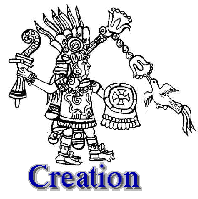
The Aztec myths of creation were gathered in variant but related versions by the 16th-century Spanish friars, who worked in different locations within the Valley of Mexico and neighboring regions. An understanding of the myths helped to explain the origin of the earth and the regularity of such phenomena as the sun, the moon, the rainy season, as well as the cycle of vegetation and human beginnings. These myths established themes by which the Aztecs created and maintained relationships based on the integration of man and nature.
The Five Ages
The original creation of the earth was followed by its destruction, and a succession of four imperfect creations leading to the present fifth era. In Aztec texts each of the five creations formed an age called a "sun." The sequence of eras officially accepted in Tenochtitlan is recorded on such famous sculptural monuments as the "Stone of the Five Suns," formerly known as the "Aztec Calender," and the Coronation Tablet of Montezuma II. Among the Aztecs the first era was called "four jaguar." At the time, giants walked the earth but did not till the soil or sow maize, only living by gleaning wild fruits and roots. This imperfect era ended when a jaguar devoured the giants. The second era, "four wind," was also flawed, and was destroyed by hurricanes that magically turned the existing men into monkeys (humanlike) but not fully human creatures. The third imperfect era ended in a rain so abundunt and frequent that the earth was deluged and people were changed into fish. The fifth and present era was prophesied to end in earthquakes. It was at the beginning of this era that the actual sun, moon, and human beings were finally created.
The creation of the sun and moon
An account of how the sun was created at the beginning of the fifth era was recorded as follows. Two gods volunteered to sacrifice themselves to become the sun. In preparation, the one named Tecuciztecatl laid out a sacrificial kit of the most costly materials. His fir branches were of quetzal feathers; his grass balls were of gold; his maguey spines were of moreover (which was the best kind). The other volunteer, an impoverished deity named Nanauatzin, could only afford green rushes, pine needles, actual maguey spines, and his own blood; and for incense, the scabs from his sores. Four nights of penance were spent atop the Moon Pyramid and the Pyramid of the Sun at Teothuacan. On the fifth night the two volunteers were ceremonially dressed and brought before a great hearth where a bonfire was blazing. At midnight the assembled gods asked Tecuciztecatl to jump into the fire. But the immense heat was too much for him and after four failed attempts, Nanautzin was called and after gathering courage, he jumped into the flame. Seeing this, Tecuciztecatl followed. After all of this, Tecuciztecatl rose as the moon, and to darken its first brilliance on of the gods threw a rabbit in his face. But the soon and Moon were still stationary, to fix this, all the gods sacrificed themselves and Ehecatl blew and blew. The sun and the moon were sent on their paths by day and night respectively.
The creation of humankind
The final episode of the creation myth was when Quetzalcoatl, descending to the underworld regions of the dead gathered a heap of bones from past generations. He then sprinkled them with his own blood and ground them up to create a new humanity.

Creation